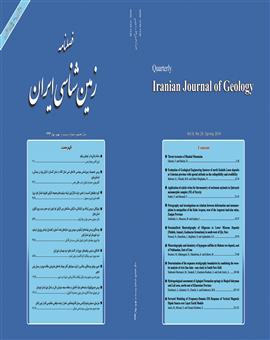معرفی کانسار مس ماری بعنوان یک ذخیره چینه¬کران نوع مانتو در زون طارم، شمال غرب ایران
محورهای موضوعی :
مهدی مرادی
1
,
سجاد مغفوری
2
,
محسن موءید
3
![]() ,
وحید فریداصل
4
,
وحید فریداصل
4
1 - شهید بهشتی
2 - دانشگاه تبریز
3 - دانشگاه تبریز
4 - دانشگاه تبریز
کلید واژه: کانسار مس ماری چینه¬, کران تیپ مانتوتراکی آندزیت مگاپورفیری زون طارم,
چکیده مقاله :
کانسار مس ماری در شمال غرب ایران و در منطقه طارم در شمال زنجان واقع شده است. این کانی سازی از نوع چینه کران و سنگ درونگیر آن، تراکی آندزیت مگا پورفیری به سن ائوسن است. سولفیدهای اصلی مس شامل بورنیت، کالکوسیت و کالکوپیریت عمدتا همراه با پیریت می باشند. بافت های موجود در کانی سازی شامل پرکننده فضای خالی، دانه پراکنده، رگه- رگچه ای و جانشینی است. سنگهاي آتشفشانی محدوده مورد مطالعه بيشتر دارای تركيب حدواسط تا اسيدي با سرشت شوشونیتی و پتاسیم بالا بوده و یک محيط کششی ریفتی درون کمانی را نشان می دهند. دگرسانی های کربناتی، کلریتی، اپیدوتی و سریسیتی در سنگ میزبان دیده می شوند. فراوانی مس و نقره در تراکی آندزیت مگاپورفیری سالم به ترتیب تا 3200 و 216 قسمت در میلیون می باشد. بر اساس ویژگیهای اساسی توده کانه دار ماری از جمله محیط تکتونیکی، سنگ دربرگیرنده، حالت چینه کران، کانیشناسی، محتوای فلزی و دگرسانی و مقایسه این ویژگی ها با ذخایر مس تیپ مانتو (Manto- type)، کانسار مس ماری میتواند به-عنوان یک ذخیره مس تیپ مانتو در شمال غرب ایران معرفی شود. همانند سایر کانسارهای مشابه این تیپ در دنیا، سه مرحله اصلی برای کانی سازی در کانسار ماری می توان در نظر گرفت. مرحله اول شامل فعالیت آتشفشانی زیردریائی و فوران گدازه تراکی آندزیت مگا پورفیری به همراه دگرسانی ناحیه ای پروپیلیتی می باشد. در مرحله دوم، دیاژنز اولیه و فعالیت میکروارگانیسم های احیاکننده سولفات باعث تشکیل پیریت هم به صورت پرکننده فضای خالی و هم به صورت دانه پراکنده در واحد تراکی آندزیتی میزبان شده است. نهایتاً در مرحله سوم، افزایش ضخامت رسوبات، فرونشست حوضه و دیاژنز تدفینی به همراه ورود سیالات غنی از مس به داخل واحد میزبان احیایی موجب جانشینی سولفیدهای مس به جای پیریت های اولیه و کانی زایی در کانسار ماری شده است.
Similar to other deposits of this type in the world, three major stages could be considered for mineralization in Mari copper deposit. The Mari Copper deposit is located in the northwest of Iran and Tarom metallogenic zone in the north of Zanjan. The ore-body is strata-bound and hosted by the Eocene mega-porphyritic andesites. The major copper sulfides are bornite, chalcocite, and chalcopyrite associated mainly with pyrite that represent open-space filling, disseminated, vein-veinlet, and replacement textures. The volcanic rocks of the study area mostly represent intermediate to acidic composition with high potassium shoshonitic magmatic series related to intra-arc rift environments. Wall rock alterations include carbonatization, chloritization, epidotization, and sericitization. The abundances of Cu and Ag in fresh mega-porphyritic andesite are up to 3200 and 216 ppm respectively. Based on the main characteristics of Mari ore body such as tectonic setting, host rock, strata-bound form, mineralogy, metal content, and wall rock alterations and comparison of these features with Manto - type copper deposits, Mari Cu deposit can be introduced as a Manto -type Cu deposit in NW Iran. The first stage includes submarine volcanic activity and eruption of mega-porphyritic andesitic lava associated with regional propylitic alteration. In the second stage, the early diagenesis and the activity of sulfate-reducing micro-organisms resulted in the generation of pyrite in the form of open-space filling and disseminated in the mega-porphyritic andesite. Finally, in the third stage, increasing of the thickness of sediments, basin subsidence, and burial diagenesis accompanied with the entry of metal-rich fluids into the reduced host rock, caused the replacement of the first stage pyrites by copper sulfides and mineralization in the Mari deposit.
